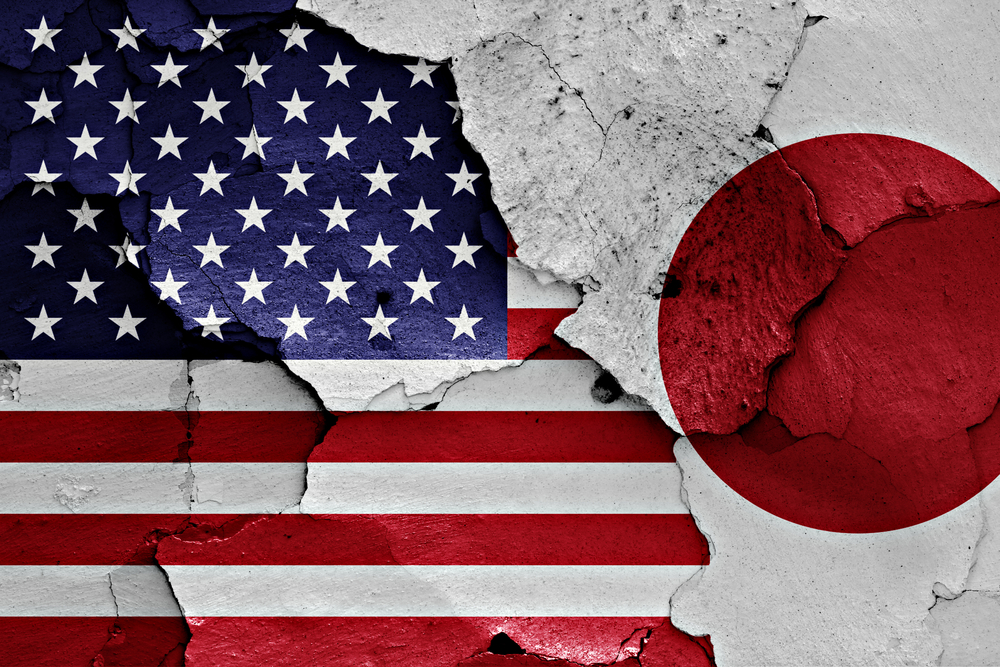Japan’s central bank has taken a page from the European playbook and implemented negative interest rates. Wait. Who cares about Japan? Japan has been in a funk, it feels like, since the Cubs last won the World Series (1908, if you care). Everything else about Japan’s economy, what does it matter here at home?
Because Japan is us.
And that ain’t good.
Japan has put the force of Atlas into moving heaven and earth in hopes of jump-starting its impotent economy. And yet … Japan’s economy remains impotent. No matter how many hundreds of trillions of yen Japan has thrown at resuscitating its economy over the last two-plus decades, the thing lays on the gurney like a brain-dead accident victim, with all the relatives gathered around and praying to a god who’s trying to tell the Japanese, “Your prescription for survival is stupid!”
Which is exactly what’s happening in America on a bit of a lag.
Why do I say “another domino down”?
Because we’ve seen a lot of dominos fall in recent weeks, and they all reveal one increasingly obvious probability: The Federal Reserve cannot — and will not — raise interest rates. Honestly, I am coming around to the view that we might not see another interest-rate increase in America for a generation.
The European Central Bank is pledging to open up the floodgates and pour every euro it can print into the economy. China is purposefully depreciating the yuan to counterbalance U.S. dollar strength that has undermined the Chinese economy. The economy here in America — despite the prevarications of Obama and his economic spin doctors, as well as Wall Street simpletons who are either blind or stupid or both — is racing toward recession. The manufacturing economy is contracting.
Employment gains are slowing, and the jobs created are largely crap. Business sentiment stinks. Historically high corporate profits are getting pinched. The dollar is much too strong for exporters, who are reporting horrible numbers.
And in this world the Fed has the temerity to suggest more rate hikes are in the offing?
Ha! (But that’s only because I can’t curse here!)
Raising rates would:
- Shove the dollar up even more relative to the euro, the yen and the yuan, crushing U.S. exporters and making imports so much cheaper here at home that U.S. companies struggle to sell their products in their home market.
- Shove GDP growth down even lower … and GDP growth, as we saw in the exceedingly weak fourth quarter, is no shining star.
What we’re looking at is Japan — American style.
We’re looking at a return to declining interest rates and, quite likely, a move into negative rates here at home — a concept that those at the highest levels of the Federal Reserve are even talking about.
There is simply no way America can buck a global trend when three of the other four largest economies on the planet are driving down rates and driving down the value of their currency. The U.S. likes to go it alone on a lot of things, but it will never survive as an island in this particular economic ocean.
The U.S. ultimately will have to play ball with the other kids, even if doesn’t want to. It will have to move toward negative rates or risk the dollar getting so strong that the strength, ironically, weakens America.
The Plan Failed
In academic and central bank theory, negative rates will force banks to get cash out the door and into the hands of borrowers. And, in theory, it will force consumers to pull money out of the bank and do something else with the money — namely, invest it or spend it.
Of course, the gap between academic theory and economic reality is quite often measured in astronomical distances.
If the economic theories that central banks are working with these days were of any real value, all the previous unconventional monetary measures such as quantitative easing and interest rates near zero would have already obviated the need for negative rates.
And yet … here we are.
Something has failed.
It has failed at a central bank level … and, more importantly, it has primarily failed at a Western governmental level. Governments have accumulated too much debt, funding too many egregiously expensive sops to the super-rich, to corporations wanting special treatment, to retirees whose incomes should negate their access to Social Security and prescription-drug coverage, to the lackadaisical willing to subsist on government handouts instead of working in a job beneath their supposed station in life, to a bureaucratic philosophy of excessive regulations across all businesses that rob America of meaningful jobs because the cost of employing someone is too high.
The list of transgressions and transgressors is long.
The solution, as I say time and again, is physical gold.
Despite dollar strength — historically a harbinger of lower gold prices – gold has held up quite well. It has rallied this year as most assets slide. It’s a message that the future is not higher interest rates in America. It’s a message that lower rates — and a weaker dollar — are our future.
It’s a message that a financial crisis, likely tied to currency or debt or both, is a distinct possibility, and that gold will play a role in reckoning.
So, yeah, that’s why Japan is important to us. It tells us the future…
Until next time, stay Sovereign…

Jeff D. Opdyke
Editor, Frontline Investor



